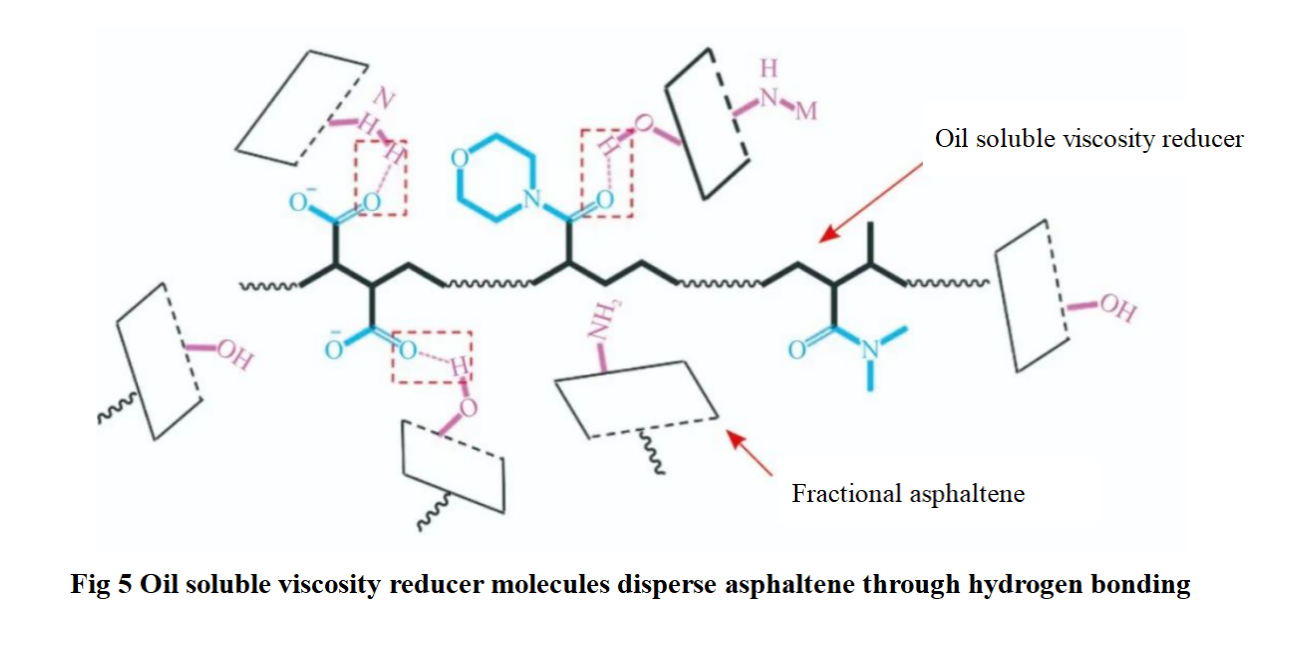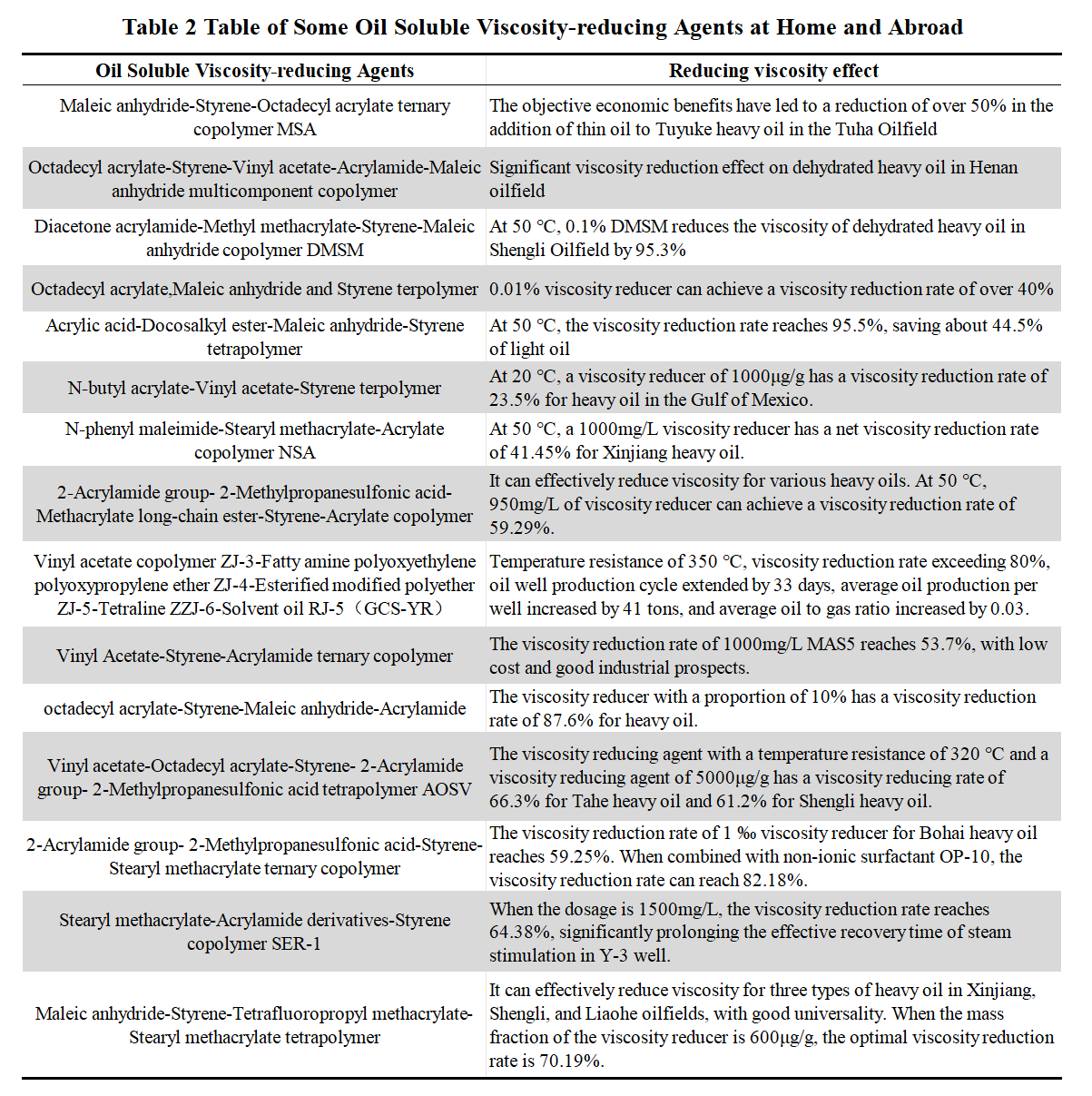Research Progress in Chemical Viscosity Reduction Technology for Medium to Deep Heavy Oil (Part 3)
3.2 Oil Soluble Viscosity Reducer
In order to overcome the problem of dehydration in emulsification and viscosity reduction technology, oil soluble viscosity reducer technology has gradually developed on the basis of crude oil pour point reduction. The mechanism of viscosity reduction mainly lies in the following three aspects: ①.The polar groups in the molecules of oil soluble viscosity reducer can form stronger hydrogen bonds with asphaltene molecules, penetrate into the sheet-like structure of gum asphaltene molecules, disperse macromolecular aggregates, and thus reduce the viscosity of heavy oil (Figure 5); ②.The long-chain alkyl groups in the molecules of oil soluble viscosity reducers can be distributed on the surface of resin and asphaltene aggregates to form a non-polar solvation layer, which hinders the re accumulation of resin and asphaltene molecules; ③.According to the principle of intermolecular similarity and solubility, oil soluble viscosity reducer molecules containing aromatic groups such as benzene rings can dissolve well in heavy oil, and then peel off the aggregates of glial asphaltene molecules. Table 2 lists some oil soluble viscosity reducers reported domestically and internationally in recent years.


At present, the oil soluble viscosity reducers reported domestically and internationally mainly include condensate type, polymer type, and polymer surfactant type viscosity reducers. Condenses have opened the way for oil soluble viscosity reduction, and earlier viscosity and pour point depressants belong to this category, mainly including chlorinated paraffin and condensation products of naphthalene and phenols. However, the viscosity reduction rate of condensed type viscosity reducers is generally not high, and they only have a certain viscosity reduction effect on domestic waxy heavy oil at low temperatures. There have been no reports of effective viscosity reduction on deep heavy oil so far.
Polymer is currently the most widely used oil soluble viscosity reducer in China, mainly are the product of homopolymerization or copolymerization of unsaturated monomers such as olefins, unsaturated esters, and maleic anhydride. Xiang Minghui and others synthesized various ternary copolymers using octadecyl acrylate, maleic anhydride, and styrene as monomers. When the monomer ratio is 6:2:1, the viscosity reduction effect is the best, and a 0.01% viscosity reducer can increase the viscosity reduction rate to over 40%. Guo et al. synthesized a quaternary copolymer of acrylic acid, dodecyl ester, maleic anhydride, and styrene, with a viscosity reduction rate of 95.5% at 50℃. The on-site test results show that adding a viscosity reducer can save 44.5% of light oil and achieve good results.
In recent years, scholars have improved the viscosity reduction effect of oil soluble viscosity reducers by optimizing the functional groups such as polar and surfactant groups, alkyl side chains, and aromatic groups. Chen Ningning et al. synthesized a ternary copolymer using octadecyl acrylate, styrene, and maleic anhydride as raw materials. Based on this, polar functional group acrylamide was introduced to synthesize a quaternary copolymer. The experimental results show that the viscosity reduction effect of quaternary copolymers is significantly better than that of ternary copolymers, and the viscosity reduction rate of heavy oil is increased from 79.4% to 87.6% under the same conditions. Li Yang et al. synthesized a new oil soluble heavy oil viscosity reducer AMS using dodecyl acrylate and α- Methyl Styrene as raw materials, and adding the surface active group 2-Acrylamide hexadecane sulfonic acid (AMC16S). AMS achieved a viscosity reduction rate of 56.94% for Tahe heavy oil at a dosage of 4000 mg/L. Gaidecheng et al. grafted aromatic functional groups such as aniline, 2-aminobenzimidazole, and 2-naphthylamine onto the side chains of polymers, and investigated the effect of the aromaticity of the side chains on the viscosity reduction effect of oil soluble viscosity reducers. The results showed that the viscosity reducer containing naphthylamine was the most effective in delaying the initial precipitation of asphaltene. Based on experimental results such as optical microscopy, the author speculated that in oil soluble viscosity reducers, the greater the aromaticity on the side chains of polymer molecules, the better their viscosity reduction effect. Liu Jiawei synthesized a series of ternary copolymers using styrene, vinyl acetate, and alkyl long-chain diester monomers as raw materials, which can be used as a new oil soluble viscosity reducer DMSS. He also investigated the effect of alkyl chain length on viscosity reduction. The experimental results show that under optimal conditions, a 0.8% D18MSS has a viscosity reduction rate of 55.8% for Tahe heavy oil.
The molecular weight of polymers has a significant impact on the viscosity reduction effect, with long chains having more advantages than short chains. However, when the molecular weight exceeds a certain value, the viscosity reduction effect deteriorates. Quanhongping synthesized a series of hyperbranched polyester FI as a crude oil flow improver using pentaerythritol, phthalic anhydride, and different long-chain alcohols (C14, C16, C18) as raw materials. The results showed that FI-8 with different carbon chains had the best viscosity reduction effect, with a viscosity reduction rate of 65.1%. The author believes that compared to a single carbon chain, mixed long carbon chains can better insert wax crystals, reduce crystal size, hinder the aggregation of asphaltene molecules, and reduce the viscosity of heavy oil.
Although the synthesis technology of polymer based oil soluble viscosity reducers is relatively mature and widely used at present, some scholars have innovatively explored small molecule oil soluble viscosity reducers without sticking to their own conventions. Chen Liao synthesized a small molecule oil soluble viscosity reducer containing long-chain alkyl and polar groups using pentaerythritol, octadecanol, and phthalic acid as raw materials. The results showed that the longer the long-chain composition of the viscosity reducer matched with the n-alkane composition in heavy oil, the better the viscosity reduction effect. Quanhongping synthesized a small molecule oil soluble viscosity reducer using catechol, epichlorohydrin, and stearyl chloride as raw materials, and tested its viscosity reducing effect on heavy oil in Xinjiang oilfield. The results showed that the viscosity reduction rate of heavy oil reached 52.36% at 50℃. The UV spectrophotometer, laser particle size analyzer, and yield stress test show that the small molecule viscosity reducer can penetrate deep into the stacking structure of asphaltene gum, effectively disperse asphaltene and gum, reduce the yield stress of heavy oil, and lower the viscosity of heavy oil.
In summary, oil soluble viscosity reducer avoids the post-treatment dehydration problem of emulsification and viscosity reduction, and has advantages such as low energy consumption and full contact with heavy oil, making it a promising technology for heavy oil viscosity reduction. However, objectively speaking, the oil soluble viscosity reducer technology is still in the research stage and there are still many problems: ①.The viscosity reduction effect is limited. Although oil soluble viscosity reducers can disperse and break down aggregates of gum asphalt, can not completely eliminate them. It’s treating the symptoms rather than the root cause. The degree of viscosity reduction is still limited. ②.The use of oil soluble viscosity reducer is large and the cost is high. Especially for deep heavy oil reservoirs, their viscosity base is large, and it is unreasonable to use a single viscosity reducer to reduce viscosity and meet production requirements. Generally, it needs to be used in combination with other processes, which to some extent increases the cost of using oil soluble viscosity reducers. ③.Oil soluble viscosity reducing agents can only exert their viscosity reducing effect after full contact with gum asphaltene molecules, and underground mixing is crucial. Although downhole mixers have been developed, their reliability is not high and they are not widely used on site, which further reduces the economic efficiency of oil soluble viscosity reducers. Therefore, further research on the mechanism of viscosity reduction, design and development of efficient and inexpensive oil soluble viscosity reducing agents, and optimization of downhole mixing processes are the focus of future research on oil soluble viscosity reducing agents.
3.3 Hydrothermal Catalytic Cracking for Viscosity Reduction
In the 1980s, Hyne et al. discovered that steam injection can not only reduce the viscosity of heavy oil by increasing temperature, but also cause chemical changes in certain components of heavy oil, thereby reducing the content of heavy components. Researchers have first proposed the concept of hydrothermal cracking based on this. However, in subsequent studies, researchers found that the change in viscosity of heavy oil is reversible. This is because bond breakage typically generates heteroatom free radicals (S, N and O), triggering polymerization reactions and producing larger molecules with higher viscosity. Especially for ultra heavy oil, the reversal of viscosity is more severe. To address this issue, researchers have introduced catalytic reactions into heavy oil development. Because an appropriate amount of catalyst can greatly promote the chemical reaction of heavy oil components, thereby promoting an irreversible decrease in viscosity. Therefore, the catalytic viscosity reduction technology of heavy oil hydrothermal cracking, which combines thermal viscosity reduction and chemical viscosity reduction, has emerged and gradually become a new direction for heavy oil extraction in recent years. The key to this technology is to screen or develop low-cost, stable performance, and effective hydrothermal cracking catalysts suitable for different heavy oils. Currently, there are several types of reported hydrothermal cracking catalysts, including: ①.water-soluble catalysts; ②.Oil soluble catalyst; ③.Amphiphilic catalyst; ④.Minerals, zeolites and solid superacid catalysts; ⑤.Super dispersed nano catalysts.
Water soluble catalysts mainly refer to inorganic salts of transition metal ions, such as Cu2+, Fe2+, Ni2+, etc. They are a type of catalyst that has been applied earlier and has significant effects. In the 1980s, Hyne et al. and Rivas et al. observed that nickel and cobalt salts had an impact on the hydrothermal cracking of heavy oil. Later, Clark et al. systematically studied a series of Al (III), first row transition metals Sr (III), VO (II), Cr (III), Ni (II) and Cu (II), as well as V IIIB group metal salts [Fe (II), Co (II), Ni (II), Rh (III), Os (III), Ir (III), Ru (III), Pt (II) and Pt (IV)], further confirming the influence of metal ions on hydrothermal cracking reactions. At the same time, it is concluded that Al (III) and the first row of transition metal substances have high reactivity in the hydrothermal cracking reaction of thiophene and tetrahydrothiophene. In addition, Pt (IV) is the metal with the highest activity in reducing sulfur content in group VIIIB, with sulfur removal rates of 40% and 56% for thiophene and tetrahydrothiophene, respectively. Researchers speculate that this is because the transition metal d-orbitals have good coordination ability with organic sulfur bonds, causing the C-S bonds in heavy oil molecules to break and the molecular weight to decrease.
Although water-soluble catalysts have obvious effects, they cannot be fully mixed with the oil phase, which has stimulated the development of oil-soluble catalysts. Wen et al. synthesized molybdenum oleate as an oil soluble catalyst using MoO3 as a precursor and oleic acid as a raw material. The experimental results showed that using a 0.5% catalyst, the viscosity of heavy oil can be reduced by 90% after 24 hours at 240℃. The overall decrease in viscosity and improvement in recovery rate in the field experiments conducted in Liaohe Oilfield are consistent with laboratory results. Liu Yongjian et al. modified the molybdenum oleate catalyst with emulsifiers to enhance its activity. After adding 0.1% emulsifier, the viscosity of heavy oil decreased by more than 90% at 200℃. Similarly, Zhao Xiaofei et al. studied the thermal stability, durability, and viscosity reduction effects of nickel (II) oleate and cobalt (II) oleate as catalysts using petroleum sulfonates as emulsifiers and toluene as hydrogen donors. Using a catalyst dosage as low as 0.4%, the viscosity of heavy oil decreased by 90% and the sulfur content decreased by 87.5% at 180℃. In addition, nickel (II) naphthenate and iron (II) naphthenate, as well as organic nickel (II) and cobalt (II) salts, have also achieved significant results in reducing the viscosity of heavy oil as oil soluble catalysts.
